Have you ever beamed from receiving a thoughtful compliment? The need to feel seen and valued extends beyond the workplace – it's human nature. It's also what makes employee recognition such a critical part of a healthy culture.
Employee recognition programs not only boost morale and increase engagement, they also increase employee productivity.
According to Deloitte, the No.1 reason for leaving a job is a lack of recognition. Companies with employee recognition programs have a 31% lower turnover rate and are 12 times more likely to have better business outcomes.
The Need to Recognize Employees Is Pressing
Remote and hybrid work arrangements also make the need for employee recognition programs more pressing.
While working remotely is a perk that can contribute to employee retention, a recent Vyopta survey revealed that executives feel challenged when it comes to keeping remote workers engaged and connected.
When asked what would most increase existing employee engagement among remote workers, executives' top answer was highlighting individual performance publicly through efforts like awards or promotions.
In other words, senior leaders are seeing the value of employee recognition and thinking about putting systems in place to drive it.
The First Step to Build a Great Employee Recognition Program
The tricky part is doing it right, as not all employees feel recognized – 29% of employees haven't received recognition for good work in over a year, if at all, according to Zippia. So, how do you go about building an effective employee recognition program?
The stats above are eye-opening, but the first step is focusing on people: “Sometimes we can get lost in the numbers, focusing on ROI's and deliverables. Remember that when you're putting a recognition program in place, the main focus is on making your people feel valued, heard, and part of something bigger," says Jonathan Braziller, Onboarding and Engagement Specialist at Applauz.
"If just one person spends the rest of their day smiling or goes home and tells their friends or family about how their company actually cares about them, well, that's something to celebrate."
Everything you need to know about employee recognition
10 Companies With the Best Employee Recognition Programs
The Disney Company
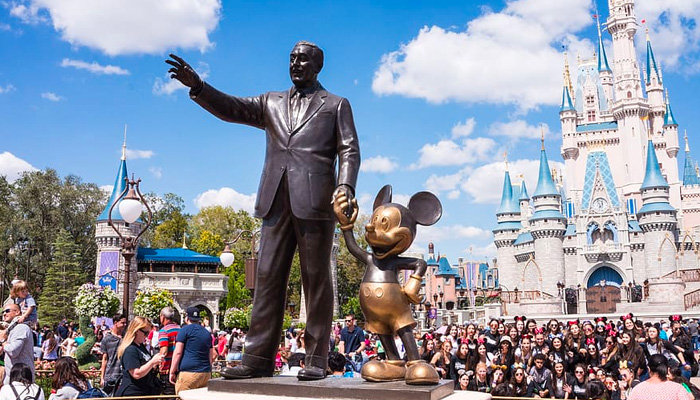
If you're ready to learn how to put an amazing employee recognition program in place, get some inspiration from different organizations and dive into some of the best practices out there.
Here are 10 companies with the best employee recognition programs along with key factors to keep in mind as you create your own.
The Disney Company
Recognizing and celebrating staff members has been a pillar of The Disney Company's culture for decades. The company has a multifaceted approach when it comes to employee recognition programs.
For example, The Walt Disney Legacy Award is the highest honor that a Disney Parks, Experiences & Products employee can receive. Less than 1% of workers receive it, so it's all about exceptional performance.
There's also a peer-to-peer recognition program where employees send each other positive notes year-round, as well as service and lifetime achievement awards and other special pins and celebrations.
The #CastCompliment initiative, for example, is a hashtag that allows a shoutout to be formally recorded and forwarded to senior leadership. Disney regularly wins awards for its workplace culture, so it's no surprise that its employee recognition efforts are so thorough.
Takeaway: Adopt a 360-degree approach when building an employee recognition program – you don't need to limit yourself to one system or tool.
Apple
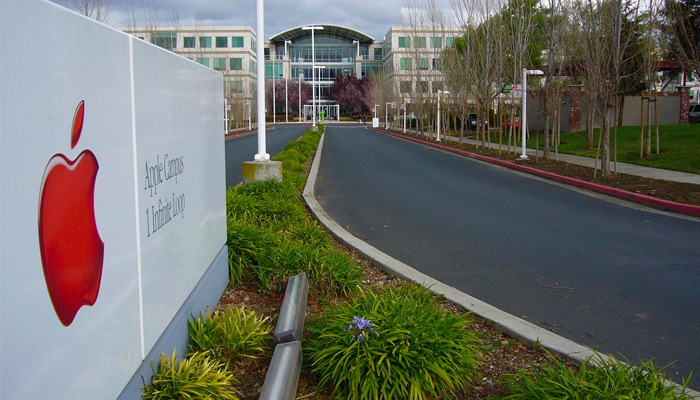
Apple's employee recognition program is heavily performance-driven. There's a system for earning rewards based on employee performance (and the organization's financial performance).
These employee rewards include cash bonuses and stock, as well as perks such as free or discounted products and time off.
Public recognition is also part of the tech giant's employee recognition program. For example, the Apple 10-Year Award is given to employees who have been with the company for a decade. Fun fact: One of its recipients once put up his award for auction on eBay and it sold for a whopping $35,000.
Takeaway: Offer incentives that people care about, such as cash, shares or time off.
Zappos
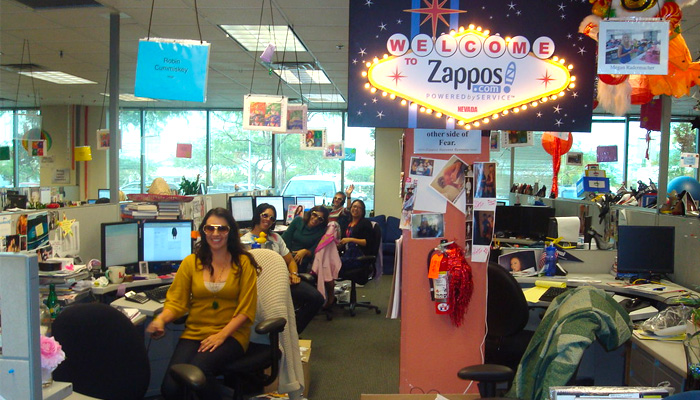
Online retailer Zappos puts a fun spin on employee recognition with its coworker bonus program. The program allows workers to award an extra $50 to a coworker each month for “WOWing” them (one of the company's core values/catchphrases).
The organization even has its own currency called “Zollar,” which can be spent on things like branded swag, movie tickets, charitable donations, or a raffle that gives you the chance to win a bigger prize. Employees can also reward each other with premium parking spaces.
In addition to the gamified perks above, Zappos also offers a Grant-a-Wish program, where employees can both submit and grant wishes such as learning how to play an instrument or getting concert tickets.
Here's how it works: an employee makes a wish known through a program called Wishes, which everyone has access to. “Fairies” can then choose to grant the wish, which leads to a face-to-face introduction. The company also grants employee wishes on a regular basis.
Takeaway: Align your employee recognition program with company values – and make it fun.
HPE
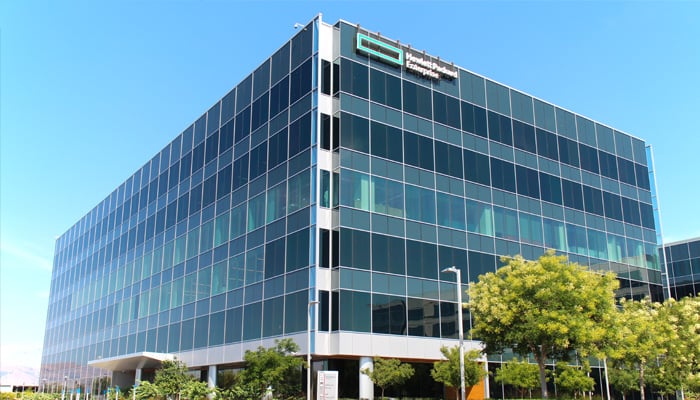
Every year, Hewlett Packard Enterprise employees across the world take a break from work to come together and enjoy various activities during Team Member Appreciation Day. “[It's] an important day to stop and thank employees.
But, employee appreciation can't be just a day. It's a spirit, an attitude, a belief that carries through every day of the year,” wrote Alan May, HPE's Executive Vice President and Chief People Officer, in a 2021 blog post.
The company seems to be staying true to this ethos: It has been recognized as a Great Place to Work among other industry awards, such as being named one of the Top 50 Companies for Executive Women by The National Association for Female Executives (NAFE) and being recognized as one of Canada's Best Diversity Employers.
Takeaway: Foster the mindset that recognition should be a daily practice – not a once-a-year effort.
Southwest Airlines
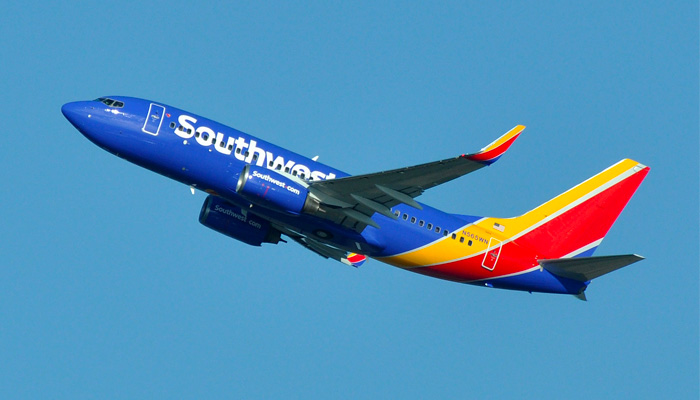
Southwest Airlines has turned peer-to-peer recognition into an exciting way to travel more. The airline's recognition program is called SWAG, which stands for Southwest Airlines Gratitude.
Using the SWAG platform, staffers can send each other notes of gratitude called “Kick Tails” or nominate a peer for an award that comes with SWAG Points.
These points can be used to buy gift cards, and experiences or be exchanged for "Rapid Rewards points" (the airline's travel reward program). On top of this system, employees get to be celebrated when they reach different milestones within their journey with the company.
Takeaway: Make it easy for employees to celebrate and recognize each other on a regular basis.
Unilever
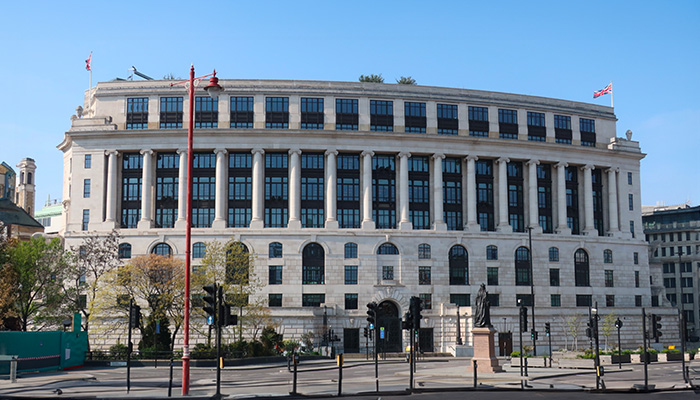
Consumer goods company Unilever uses different employee recognition strategies in different locations, as it has offices in more than 190 countries. However, its flagship global employee recognition program is called The Unilever Heroes Award.
It honors employees who have made outstanding contributions to the company during the course of a year.
Award recipients are invited to the Change Leaders Conference, an exclusive event where hundreds of Unilever senior managers get together on an annual basis.
Takeaway: Consider extending an exclusive invite to reward excellent performance.
American Airlines
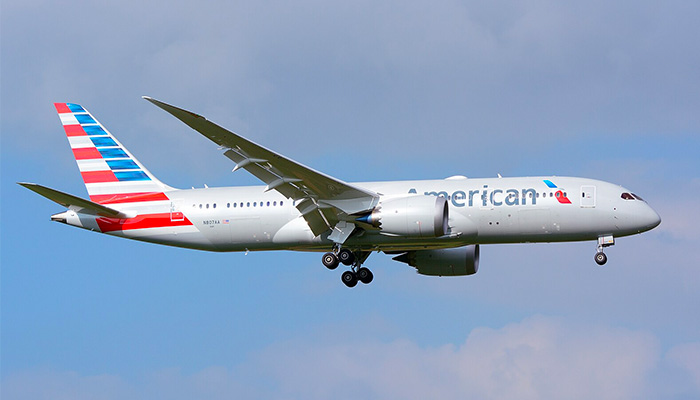
With over 100,000 employees internationally, American Airlines has various measures in place to ensure that recognition is widespread and accessible.
The company's Nonstop Thanks platform, which can be used via a mobile app, allows both managers and team members to share appreciation and use features like eCards to stay connected.
Managers also use the app to make sure positive customer feedback is shared. During the pandemic, these recognition efforts helped unify teams and strengthen company culture in the midst of uncertainty and difficult times.
Takeaway: The tech that you choose for your employee recognition program matters, especially if you're part of a large organization.
Typeform
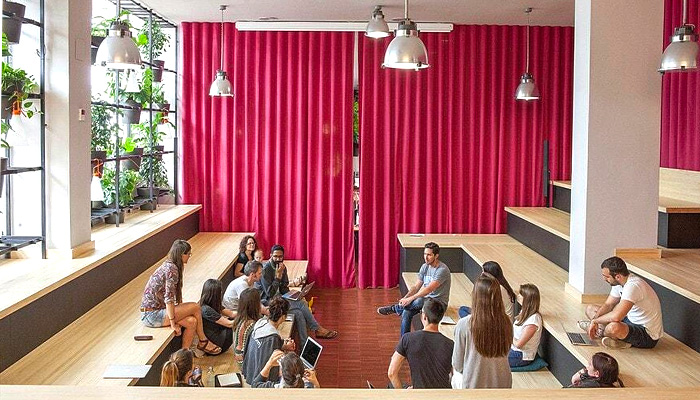
Survey-based company Typeform also gamifies its employee recognition program thanks to the use of “merit money” for peer-to-peer recognition. Employees are given “typecoins” at the start of every month.
They can use these to show appreciation to their teammates. The rewards can be converted to Amazon, Uber, or Starbucks gift cards, or even cash. Typeform also has a quirky practice called Spontaneous Applause. It invites people to start clapping for a job well done, with the whole office joining in.
Takeaway: Incorporate a unique and meaningful recognition ritual into your culture.
DHL
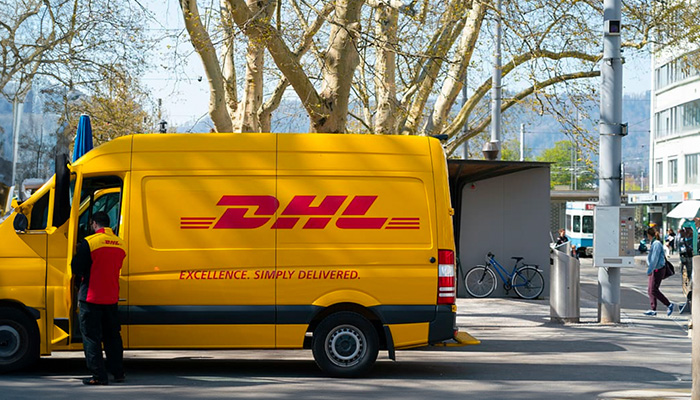
DHL Global Forwarding (DGF) regularly snags spots on the Great Place to Work list. Every year, the logistics company hosts Employee Appreciation Week, which includes a global program of events around a theme.
For instance, one of the recent editions was focused on honoring Freight Forwarding experts and celebrating diversity, inclusion, and equality under the theme “DGF Moves As One.” Employees from different locations took part in a giant company dance.
There were regional playlists with songs and dances from every country, which was an entertaining way to bring everyone together and stay on theme.
The company also has an Employee of the Quarter/Year program to recognize outstanding team members and broadcast their accomplishments.
Takeaway: There are creative ways to bring scattered teams together and have them share a moment.
Cisco
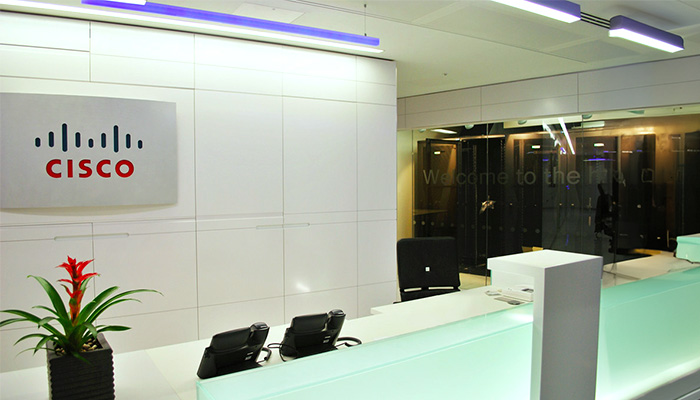
IT company Cisco's employee recognition program is called Connected Recognition. It's funded at 1% of payroll but allows employees the opportunity to collect significant rewards as their peers and managers nominate them for various awards through the platform.
“I saved up several rewards in Connected Recognition to help me fund a seven-day stay at Swissotel's Kamala Beach resort in Thailand this past December. The rewards meant that I stayed in a more upscale resort than I would have booked if I were paying for it on my own.
Of course, I was touting my awesome #LoveWhereYouWork experience on social media, and when my friends read my posts, they all started asking me how to get a job at Cisco,” shared David Faik, Procurement Manager, Global Procurement Services, in a company blog post.
Takeaway: Weigh different financing options to help make your recognition program as exciting as it can be.
Key Components of an Effective Employee Recognition Program
Do you notice any trends in the employee recognition programs above? While building your employee recognition efforts based on your unique culture and organizational structure is key, effective employee recognition programs do share a few common elements.
A focus on authentic ways to recognize employees
First, they are based on authentic recognition. Successful employee recognition programs provide the foundation upon which spontaneous and genuine moments of recognition can happen, either between peers or when a manager wants to share a piece of positive feedback with a report.
This may seem like a no-brainer, but it's crucial. If appreciation is perceived as insincere, it can make team members feel disrespected and kill morale.
Gallup research shows that employees who strongly agree that they receive authentic recognition are seven times as likely to report that they are treated with respect at work compared with those who don't strongly agree that they receive authentic recognition.
A mix of recognition methods
The best employee recognition programs also offer unique ways to give recognition. “I think there's a difference between getting a pizza party versus receiving an authentic recognition for a job well done. The fact that on top of that recognition, I can be rewarded through points, badges, or something unique…I think that's just awesome,” says Braziller.
Recognizing employees requires a 360-degree approach. Different people value different things -- say, cash rewards versus a shoutout from senior leadership for a job well done. Including a mix of recognition methods that align with organizational values and goals ensures that employees feel appreciated.
Rewards that tap into intrinsic and extrinsic motivation
Effective recognition programs also balance intrinsic and extrinsic motivation. Intrinsic motivation is the idea of being motivated because of internal rewards such as feeling proud of yourself for doing good work.
Extrinsic motivation takes the form of external incentives, such as getting a cash bonus for driving results. Even though intrinsic motivation is powerful, the best recognition programs do include some form of external reward.
“As HR Specialists, we learn that intrinsic rewards are more valuable than extrinsic ones. We're taught gamification is sometimes a gimmick to get employees to be happy." adds Braziller.
"In the case of Applauz and peer-to-peer recognition programs using points, having the ability to use points to acknowledge and recognize a colleague for an amazing feat--be it their happy energy at work every day or finishing a huge project--is a little extra extrinsic ‘icing on the cake.'"
A personalized approach to boost engagement and job satisfaction
If you want to build an impactful employee recognition program, adapting your efforts to the unique demands of your team and culture is crucial. As Gallup puts it, employees need "more than a fleeting warm-fuzzy feeling and a good paycheck (even if it helps them respond positively on employee engagement survey questions) to invest in their work and achieve more for your company."
You can't just copy-paste the tactics of the successful recognition programs above and expect engagement and job satisfaction to increase. That said, you can use them for inspiration to bridge gaps where needed.
Gallup says the drivers of engagement are purpose, development, a caring manager, ongoing conversations and a focus on strengths. Suppose that you run an employee engagement survey and realize that team members crave more professional development. You could use that insight to tie recognition to professional development-oriented rewards.
Employee Recognition Programs: Best Practices
To help you design your employee recognition program and boost employee morale, here are some best practices to keep in mind.
Get clear on your objectives
What do you want your recognition program to accomplish? Do you want employees to feel valued? Are you looking to reduce turnover rates? Getting clear on your intentions and goals when recognizing employees will help you make the right choices for you and your team.
Personalize your program based on your culture
Your employee recognition program is an opportunity to build and promote workplace culture. From inventing your own currency to giving your program a fun branded name, find creative ways to personalize things.
Even more importantly, make sure that your recognition strategies are aligned with your core organizational values.
Involve your employees in the process
Don't be afraid to run an employee survey or ask for the feedback of different people and departments when creating your employee recognition program.
You may glean helpful insights, as this can help you understand how people prefer to be rewarded or recognized and what would be most meaningful to them.
Pick the right employee recognition platform
Picking the best employee recognition software to turn employee recognition efforts into a system is key.
For example, Applauz includes features like a social platform, custom badges and rewards, and automatic reminders for celebrations such as birthdays and work anniversaries.
It also allows employees at all levels of an organization to quickly and easily recognize whomever they want. The right tech can make or break the implementation of your recognition program, so pick wisely.
Include different types of recognition to reward employees
You don't need to choose between hosting quarterly awards and using a peer-to-peer recognition tool. In fact, including a variety of elements in your employee recognition program is better. It takes time to build new habits. With several mechanisms in place, the act of recognizing each other and prioritizing recognition becomes more natural.
Aim for authenticity
Remember that your system should make it simple to give authentic recognition regularly. You don't want to force recognition on your people.
Find ways to encourage it naturally instead. Lead by example and be the first to use your recognition program on a regular basis. Ask leaders and managers to follow suit. Build recognition into your communication channels. Then, let the magic unfold.
Track and measure results
You can always optimize your program over time if you notice that some efforts are more successful than others. In order to do that, you'll have to track and measure results.
Again, a platform like Applauz can assist this process, as it includes easy-to-read engagement dashboards that help you understand employee participation and identify areas of improvement.
With the information and examples above, it's time to get started on creating your own employee recognition program. Make sure it fits your culture, make it appealing to your people, and feel free to mix and match different strategies for the best results.
Start Your Employee Rewards & Recognition Program with Applauz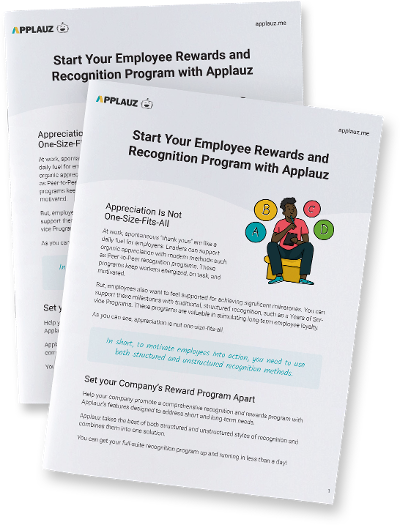
About the author
Anouare Abdou
Anouare Abdou is a seasoned HR and business writer passionate about leadership, productivity, and the future of work. Her words have appeared in Business Insider, The Ladders, Thrive Global and more.

